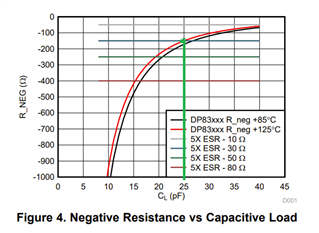Hi Team,
we have some questions regarding SNLA290 AppNote.
1) CLoad in equation (1) page 4 - corresponds to the load capacitance specified in the datasheet of the quartz crystal ?
2) Cpin in equation (1) page 4 - is the sum of Xi + Xo capacitance of the input and output pin of the DP83867CS ?
3) The Cload calculation on page 5 is wrong, assuming Cpin = 2*1pF, Cstray = 2pF and CL1=CL2= 30pF then the Cload = 15 + 2 + 2 = 19pF and not 18pF ?
* EDIT, the calculation is ok, i used the wrong parameters.
4) How is the component tolerance in ppm estimated to be +/-8ppm ?
5) In equation (2) on page 5 what value is the -gM parameter?
6) In equation (2) on page 5 the omega represents = 2*f*pi , where f is the quartz frequnecy 25MHz ?
7) The Figure 4 x-axis is CL , is this CL = to CL1 = to CL2 ? or is the CL on figure 4 x-axis the load capacitance from quarz datasheet?

8)"For example, a crystal with an ESR of 30 ohms must use a load capacitance of no larger than approximately 19 pF if the expected worst case operating temperature is 125C."
is this statement correct? because if we look at the fugure 4 , the CL should be smaller then 25pF and not 19pF? Blue line is the 5* 30 ohm = 150 ohm and the intersection with red line is at 25pf.

9) in 3.9 Crystal Drive Level is mentioned that Ti PHY can work with low power qurtz down to 100uW
how can we calculate the drive level at which is the TI PHY driving the quartz?
10) in summary page 8 , the stated Load capacitance corresponds to CL1=CL2=CL=Cload discrete capacitors , or to the load capacitance of the quartz stated in datasheet ?
11) Why don't you recommend Load capacitance less than 8pF in summary? assuming that load capacitance is CL1=CL2=CL and not the load capacitance of the quartz stated in datasheet.
Best Regards,
d.

